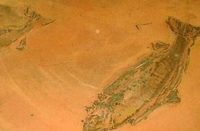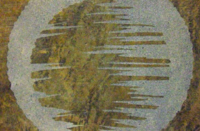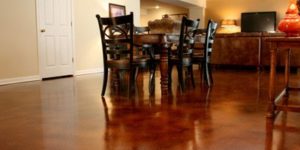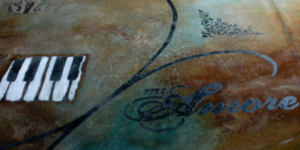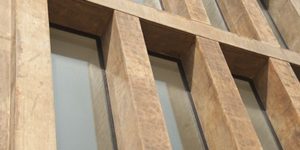
Acid-stained concrete has been popular for decades. The process of acid staining is well documented, as are the key precautionary items to look for before and during application. When I first started troubleshooting decorative concrete problems around 2001, I got a lot of calls involving acid stains. Today, I might get these calls a few times a year. Thanks to real-world experience, continuing education and better specifications, issues with acid stains have been greatly reduced. This is a testament that the industry better understands the products and process, and is using stain systems in the proper places.
When someone asked for my input on this acid-stain issue, I was immediately intrigued. The size and issues made this project interesting, although the installer and homeowner would probably have a different adjective to describe it.
The project’s parameters
This project consists of a 6,000-square-foot, smooth-finished concrete driveway with jointed 14-inch bands running the length of all sides. The center sections were acid stained a medium brown color while the outside bands were stained a dark brown. The entire driveway was sealed with a solvent-based acrylic sealer. The homeowner was looking for marbled terra-cotta and brown colors on the driveway to match the home’s Spanish motif. Acid stain is a viable option to achieve this result.
The driveway runs the length of the east side of the house and includes a half-circle turn-around in the front, as well as a parking and turn-around area in back by the garages. All sides of the driveway, except the far back side, are bordered by irrigated landscaping and/or lawn.
The application went smoothly, and the stain and sealer performed well for many months. It was only after a wet spring that white haze and discoloration started showing up. The hazy areas were more prevalent around the joints and dark borders, but they eventually spread across the entire driveway.

To the installer’s credit, he returned to solvent-wipe and eventually strip and reapply the sealer multiple times. Each time, the driveway looked good for a few weeks, only to have the discoloration return. When I saw the driveway this past spring, the haze and discoloration presented the classic signs of moisture trapped under the sealer.
The question is why?
I understand why the issue occurs after heavy rains, but why does it reoccur after stripping, drying and resealing, especially during the hot dry summer and arid winter months this region experiences?
Deciphering the conditions
Our conclusion involved the influence of both man-made and natural environmental conditions. The home sits on a lot at the bottom of a gradual hill to the east and a small recreational fishing pond to the west. When I was there, I noticed that all the water from irrigation systems from the homes up the hill to the east ran down the hill and ended up in storm drains in front of our driveway. The hillside itself and the grass at the bottom of the hill were also wet.
The home is in an upscale neighborhood, with very nicely manicured lawns and ample landscaping. While not out of the ordinary, the landscaping and irrigation in planting beds between the house and the driveway were somewhat unique. As mentioned earlier, the driveway was surrounded by irrigated planting beds and/or irrigated grass lawns.
I was at the job site midday in late April, and the ground around the driveway was soaking wet from the nearby irrigation and from water flowing downhill. We concluded that it took a few months, but heavy rains had saturated the ground. The location, at the bottom of the hill and next to a pond, combined with a tremendous man-made irrigation system surrounding the driveway, was causing the moisture issue. The fact that the moisture problem started on the edges and worked its way in supports this hypothesis.
In my opinion, and based on the multiple unsuccessful attempts of stripping and resealing, a film-forming sealer isn’t going to work on this driveway if nothing changes in regard to irrigation and ground-water levels. I recommend a moisture test and probably switching to a penetrating sealer.
Another option is adding drainage alongside the driveway to carry excess water away from the concrete. However, there’s no guarantee this will solve the problem.
Hindsight is 20/20 and Monday morning quarterbacking is part of this job, so let’s break down some of the key points.
Dark colors will show more contamination than light ones. This outcome needs to be discussed upfront.
Stained exterior work requires a higher degree of client expectation management. Extreme color variations, different surface profiles, sealer breathability issues and extra maintenance are just a few things clients can expect to encounter.
Natural environment is something I didn’t pay much attention to, but now tops my list. Water drainage from surrounding areas, and the natural layout of the land, should be on the pre-job check list. A lot at the bottom of a hill where water naturally flows to may need additional drainage.
Man-made environmental issues, such as irrigation and drainage, must be considered. The desire for lush lawns, flowers and plants, especially in arid climates, creates an unnatural level of moisture in the ground. Concrete is somewhat of a sponge, and water will always take the path of least resistance. The process of osmosis (moving fluids from high to low concentrations across a permeable substrate) as well as capillary action (flow of a liquid into a porous material without the assistance of gravity) will move water great distances through concrete. In this case almost all sides of the concrete were in constant contact with water-saturated ground that migrated through the slab by one or both of these processes.
I want to share this problem job not to draw attention to the problem itself, but rather educate and encourage those reading to look beyond the ordinary checklist in the hope of avoiding potential issues in similar situations.
